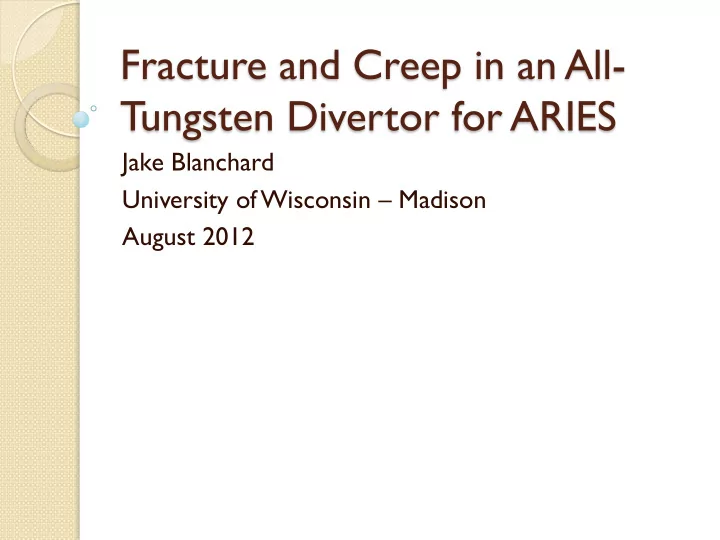

Fracture and Creep in an All- Tungsten Divertor for ARIES Jake Blanchard University of Wisconsin – Madison August 2012
Introduction The ARIES Project is exploring the feasibility of using tungsten as a structural material for plasma-facing components For now, we are assuming the material is pure tungsten, but alloys may be necessary This talk addresses two key failure modes that must be addressed by these designs ◦ Fracture ◦ Thermal creep
The Design
Major Input Parameters Parameter Value Units MW/m 2 Surface Heat 11 MW/m 3 Volumetric Heating 17.5 Coolant Pressure 10 MPa Bulk Coolant 600 C Temperature
Crack Location Finite Element Model with Crack on Coolant Channel Surface Crack-Free Stress State
Fracture Results Results for Crack Results for Crack on Previous Slide Perpendicular to Cracks Shown 4.0 16 Stress Intensity (MPa-m 1/2 ) 3.5 14 c/a=2 Stress Intensity (MPa-m 1/2 ) 3.0 12 2.5 10 2.0 8 1.5 c/a=2 6 c/a=6 1.0 4 Crack Face c/a=10 0.5 2 0.0 0 0.2 0.4 0.6 0 Crack Depth (mm) 0 0.1 0.2 0.3 0.4 0.5 0.6 Crack Depth (mm) 8 7 Stress Intensity (MPa-m 1/2 ) 6 Results for 5 Crack in Notch 4 c/a=2 (at shutdown) 3 c/a=6 c/a=10 2 1 0 0 0.2 0.4 0.6 Crack Depth (mm)
Effect of Transients 2001 Vary nominal heat flux 2000 by +/-20% and apply Temperature (oC) 20 cycles 1999 1998 No discernible variation below 1997 surface 1996 0 0.01 0.02 0.03 0.04 Time (s) 1715.40 Surface T emperature Temperature (oC) 1715.38 1715.36 1715.34 T emperature 1715.32 2.5 mm below 1715.30 surface 0 0.01 0.02 0.03 0.04 Time (s)
Surface Effect of “Small” ELM Assume 1.95 MJ deposited on divertor surface over 1.2 milliseconds 4000 Melt layer is 20 microns thick 3500 Melt Temp. Temperature ( o C) 3000 2500 Surface 2000 Depth = 17.7 um Depth = 26.6 um 1500 1000 0 0.2 0.4 0.6 0.8 1 Time (ms)
Thermal Creep 6 Displacement (mm) 5 Add Thermal Creep Model for Tungsten 4 3 Creep rates are excessive at 11 2 MW/m 2 1 0 0.14 0 5000 10000 15000 20000 0.12 Time (hr) Creep Strain (%) 0.10 Total Creep Nominal Heat Flux 0.08 Thermal Creep Pressure Creep 0.06 0.04 0.02 Reduced 0.00 Heat Flux 0 5000 10000 15000 20000 Time (hr)
Design Modifications 0.0014 0.0012 Creep Strain 0.001 0.0008 6.0 0.0006 Normalized Creep Strain 0.0004 Baseline 5.0 Heat Flux 0.0002 Reduced 4.0 Notch 0 Pressure 0 5000 10000 15000 20000 3.0 Time (hr) 2.0 1.0 Reducing Notch Depth 0.0 0.7 0.8 0.9 1 1.1 1.2 1.3 Normalized Parameter Value Varying Surface Heating or Coolant Pressure
Conclusions We have not identified any “show- stoppers” with respect to an all-tungsten divertor for ARIES Many uncertainties are still unresolved
Recommend
More recommend